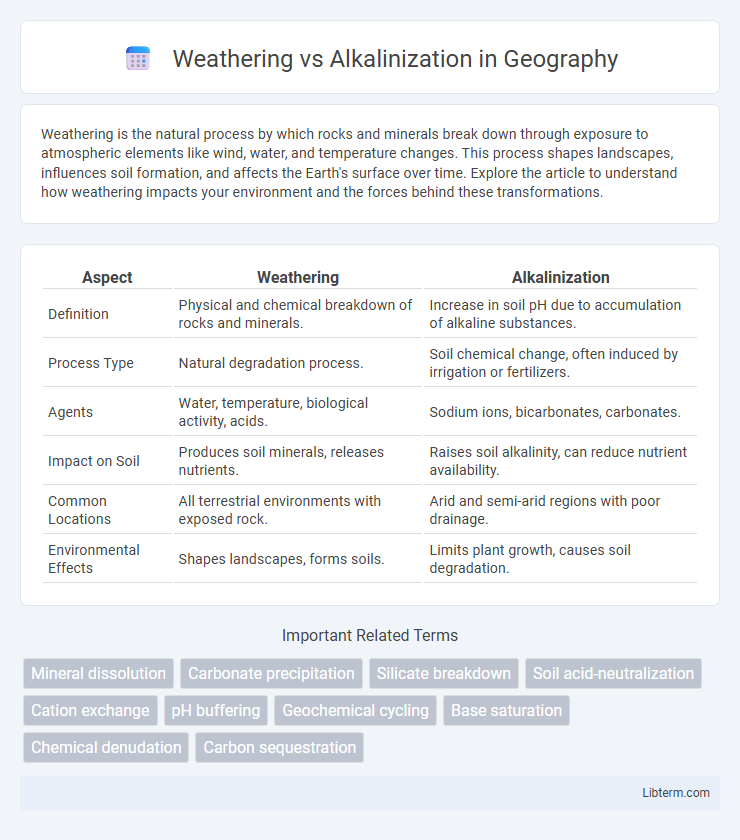Weathering is the natural process by which rocks and minerals break down through exposure to atmospheric elements like wind, water, and temperature changes. This process shapes landscapes, influences soil formation, and affects the Earth's surface over time. Explore the article to understand how weathering impacts your environment and the forces behind these transformations.
Table of Comparison
| Aspect | Weathering | Alkalinization |
|---|---|---|
| Definition | Physical and chemical breakdown of rocks and minerals. | Increase in soil pH due to accumulation of alkaline substances. |
| Process Type | Natural degradation process. | Soil chemical change, often induced by irrigation or fertilizers. |
| Agents | Water, temperature, biological activity, acids. | Sodium ions, bicarbonates, carbonates. |
| Impact on Soil | Produces soil minerals, releases nutrients. | Raises soil alkalinity, can reduce nutrient availability. |
| Common Locations | All terrestrial environments with exposed rock. | Arid and semi-arid regions with poor drainage. |
| Environmental Effects | Shapes landscapes, forms soils. | Limits plant growth, causes soil degradation. |
Introduction to Weathering and Alkalinization
Weathering is the natural process of breaking down rocks and minerals through exposure to atmospheric conditions, resulting in physical disintegration and chemical alteration. Alkalinization refers to the increase in soil pH caused by the accumulation of alkaline substances, often from weathering of specific minerals or anthropogenic sources. Understanding the interactions between weathering and alkalinization is crucial for managing soil fertility and ecosystem health in various environmental contexts.
Defining Weathering: Process and Types
Weathering is the natural breakdown of rocks and minerals through physical, chemical, and biological processes that alter their structure and composition over time. Physical weathering involves mechanical fragmentation due to temperature changes, freeze-thaw cycles, and abrasion, while chemical weathering alters minerals via reactions like hydrolysis, oxidation, and carbonation. Biological weathering includes the effects of plant roots, microorganisms, and organic acids that contribute to rock disintegration and nutrient release.
What is Alkalinization? Key Concepts
Alkalinization refers to the process that increases the pH level of a substance, making it more basic or alkaline. It is a crucial chemical reaction often used in soil science to neutralize acidity, optimize nutrient availability, and improve plant growth. Understanding alkalinization involves recognizing its impact on microbial activity, mineral solubility, and the enhancement of environmental or physiological conditions through pH adjustment.
Natural Processes: Weathering vs Alkalinization
Weathering involves the physical and chemical breakdown of rocks and minerals, releasing essential nutrients like calcium, magnesium, and potassium into the soil, which is vital for ecosystem health. Alkalinization refers to an increase in soil pH often caused by the accumulation of alkaline substances such as carbonates or bicarbonates, which can result from irrigation practices or natural processes like mineral weathering. While weathering enriches soil nutrient content, alkalinization can reduce soil fertility by limiting the availability of micronutrients, impacting plant growth and soil microbial activity.
Chemical Reactions Involved
Weathering involves chemical reactions such as hydrolysis, oxidation, and acid-base reactions that break down minerals in rocks, transforming primary minerals into secondary minerals like clay. Alkalinization primarily involves the increase of soil pH through reactions like the replacement of hydrogen ions (H+) with hydroxide ions (OH-) or alkaline cations such as calcium (Ca2+), magnesium (Mg2+), and sodium (Na+), often mediated by processes like carbonate dissolution or base saturation. These distinct chemical processes drive changes in soil chemistry, influencing nutrient availability and the mineral composition of the soil profile.
Environmental Impact of Weathering
Weathering significantly influences environmental systems by breaking down rocks and minerals, which releases essential nutrients into soil and water, supporting plant growth and ecosystem health. This natural process also aids in carbon sequestration through the chemical breakdown of silicate minerals, reducing atmospheric CO2 levels and mitigating climate change. The environmental impact of weathering varies by climate, rock type, and biological activity, shaping soil formation, water chemistry, and landscape evolution over time.
Role of Alkalinization in Ecosystems
Alkalinization plays a crucial role in ecosystems by regulating soil and water pH, enhancing nutrient availability and microbial activity essential for plant growth. This process counteracts acidification caused by organic matter decomposition and acid rain, maintaining ecological balance and supporting biodiversity. By stabilizing pH levels, alkalinization facilitates nutrient cycling and improves habitat quality for aquatic and terrestrial organisms.
Human Influence on Weathering and Alkalinization
Human activities such as industrial emissions and agriculture significantly accelerate weathering by increasing acid rain and altering soil chemistry, which enhances mineral breakdown. Urbanization and deforestation expose more rock surfaces, intensifying physical and chemical weathering processes. Furthermore, the release of alkaline substances from cement production and certain industrial waste contributes to alkalinization, impacting soil pH balance and aquatic ecosystems.
Comparative Analysis: Benefits and Drawbacks
Weathering enhances soil fertility by naturally breaking down minerals and releasing essential nutrients, promoting long-term ecosystem health, but it can be slow and influenced by climatic conditions. Alkalinization, typically achieved through adding lime, rapidly raises soil pH to improve nutrient availability and reduce soil acidity, benefiting crop yields, though it may cause micronutrient imbalances and soil structure degradation if overapplied. Comparing these processes, weathering offers sustainable nutrient cycling while alkalinization provides immediate soil condition correction, making their combined management optimal for soil quality and agricultural productivity.
Conclusion: Weathering vs Alkalinization in the Modern World
Weathering naturally alters soil composition by breaking down minerals and releasing nutrients, playing a crucial role in ecosystem sustainability. Alkalinization, often resulting from agricultural practices and industrial activities, disrupts soil pH balance, leading to decreased fertility and increased environmental risks. Understanding the distinct impacts of weathering and alkalinization is essential for developing sustainable land management strategies that protect soil health and agricultural productivity.
Weathering Infographic

 libterm.com
libterm.com